This task shows how to perform an analysis of the surfaces quality of shaded highlights.
These lines connect the surface points where the angle of incidence of the light is constant, they are called 'Isophotes'.
The brightest reflection occurs at an angle of incidence = 90°.
For the computation of the isophotes all points will be determined in which the surface normal has the same direction.
The angle between light direction and surface normal is constant.
The course of highlight lines illustrates – like reflection lines – the shape of the surface and the quality of surface matchings.
In contrast to the reflection diagnosis, the highlight diagnosis does not depend on the view direction.
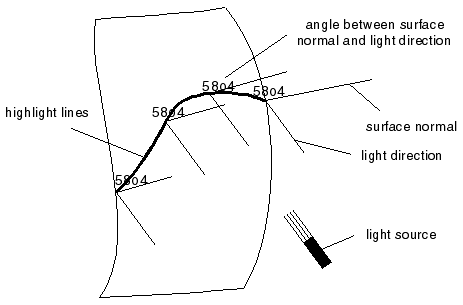
-
Click the Highlight Analysis icon
 .
.The 'Highlight Analysis' dialog box is displayed.
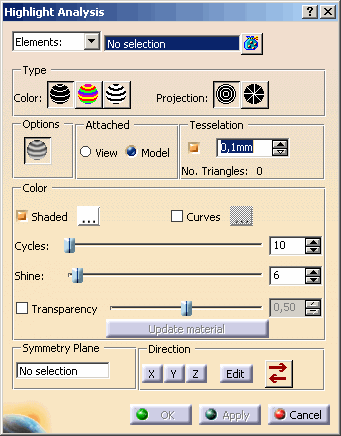
- Selection Type:
- Elements: Displays the selection field for individual selection of elements to which the analysis shall be
applied. Via the multi-selection bag, you can select several elements as well as geometrical sets.

- Display List: Displays a combo box containing all defined Display Lists instead
of the selection field.

When selecting a display list, all stored elements in this set are used as input for the analysis.
If the selected display list is modified, the analysis is updated automatically. - Global: Applies the Highlight analysis to all surfaces of the part, including surfaces created after the Highlight analysis definition.
- Elements: Displays the selection field for individual selection of elements to which the analysis shall be
applied. Via the multi-selection bag, you can select several elements as well as geometrical sets.
- Type:
- Color: You can display the Highlight analysis in the following color types:
 Highlight: The width of the brightness flow depends on the Shine.
The brightness is amplified exponentially with increasing shine factor.
Highlight: The width of the brightness flow depends on the Shine.
The brightness is amplified exponentially with increasing shine factor.
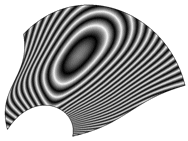
 Colored:
Displays the Highlight lines in different colors.
Colored:
Displays the Highlight lines in different colors.
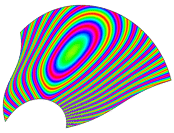
 Black and
White: Displays the Highlight lines in black and white. The width of the Highlight lines is constant. A shine
factor cannot be defined.
Black and
White: Displays the Highlight lines in black and white. The width of the Highlight lines is constant. A shine
factor cannot be defined.
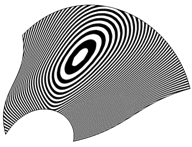
- Projection: Only available if Tessellation is selected.
For the calculation of the highlight lines, two projection modes can be used: Beam:
Calculates the highlight lines directly from the light beam of the parallel light source.
Beam:
Calculates the highlight lines directly from the light beam of the parallel light source.
The direction of the light beam can be modified using the manipulator.
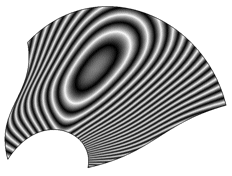
 Cylinder:
Creates the highlight lines by reflection of stripes on the interior side of an imaginary cylinder around the geometry.
Cylinder:
Creates the highlight lines by reflection of stripes on the interior side of an imaginary cylinder around the geometry.
The cylinder axis can be modified using the compass tool.

- Color: You can display the Highlight analysis in the following color types:
- Options:
 Anti-Aliasing:
Smoothes the edges of the highlight lines by an anti-alias.
Anti-Aliasing:
Smoothes the edges of the highlight lines by an anti-alias.
Anti-Aliasing OFF

Anti-Aliasing ON

- Attached: Only available for projection mode Beam.
- View: Fixes the light source to the view, i. e. in case of geometry rotations its position remains unchanged.
- Model: Fixes the light source to the model coordinate system, i. e. it will be rotated together with the geometry.
Highlights with approx. 650 Triangles

Highlights with approx. 51000 Triangles
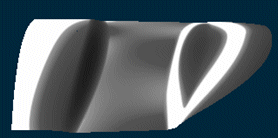
- Color :
- Shaded: The check box selects or clears the shaded display. This option is selected by default with the color
set to white.
The color button is only available for the types Highlight and Colored and activates the standard Catia Color Chooser to choose another color.

- Curves: The check box selects or clears the display of the highlight analysis as curves.
The color button activates the standard Catia Color Chooser to choose another color for the highlight curves.
This option is cleared by default with the color set to red.
Curves OFF Curves ON 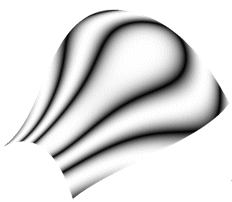

- Cycles: Sets the number of highlights to be displayedx.
Number of cycles set to 10 Number of cycles set to 70 
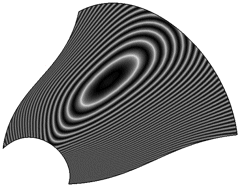
- Shine: Sets the highlight width.
Shine value set to 10 Shine value set to 70 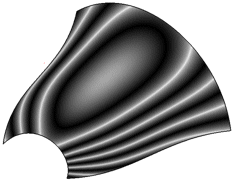

- Shaded: The check box selects or clears the shaded display. This option is selected by default with the color
set to white.
- Transparency: Computes a transparent analysis making simultaneously visible the shading of the analyzed geometry.
The intensity of the transparency can be modified via the slider and the text box.
Highlight Analysis without Transparency Highlight Analysis with Transparency 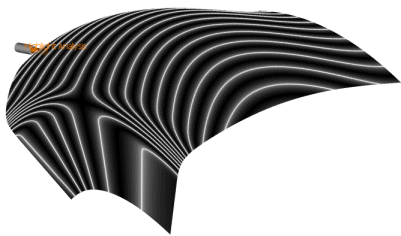
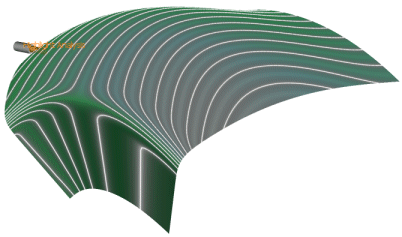
- Update material: If an individual Tessellation is used, the Highlight Analysis can neither react to material changes nor detect whether a change of material requires an update of the feature. This applies also to changes in the graphics properties. In this case, the Update material button can be used to manually trigger a re-read of the materials from the input geometry.
- Symmetry plane: Selects a symmetry plane at which the selected geometry is mirrored.
- Direction: see Defining a direction.